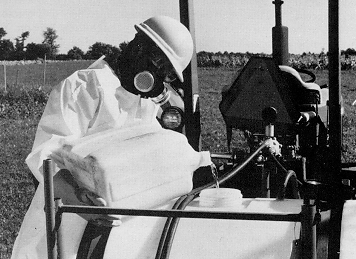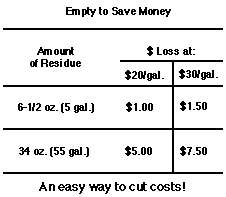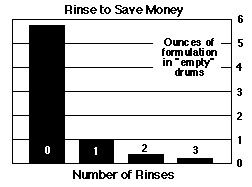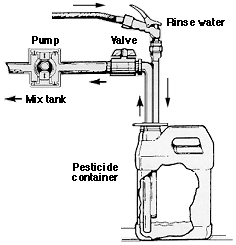Filling & mixing of pesticides - Plant Protection Measures, Crop Production | Crop Production Notes- Agricultural Engineering PDF Download
Some pesticides are used as purchased. These include baits, garden dusts, dry granular materials, aerosols, and some liquid household and livestock sprays. However, most custom applicators will stock concentrated pesticides, such as wettable powders or emulsifiable concentrates that must be diluted with other liquids before using. Water is the most common liquid used for diluting pesticides.

Goals of This Module
- Learn to determine how, when, and where to mix concentrations of pesticides.
- Understand the importance of protecting the environment from spills and the safety measures that should be taken.
- Learn how to determine the compatibility of pesticides.
When to Mix
It is best not to add the pesticide to the tank or the granules to the hopper until just before you are ready to apply. This is particularly true when you are going on a job that you have not checked previously. If the pest is different than you had expected, you may be faced with the disposal of a tankful of the wrong pesticide. On the other hand, a pest control operator treating an apartment should never carry any concentrate into the apartment. Therefore, you will have to mix the pesticide beforehand.
Safe Practices For the Applicator
The applicator is most likely to be dangerously exposed to pesticides when mixing since handling the concentrated form is hazardous. You may splash liquid concentrates on your skin or in your eyes unless they are protected. You may spill them on your clothing where they can soak through to the skin or expose whoever handles the clothing later on. You may breathe particles from highly concentrated wettable powders or from granules or dusts. You may contaminate your hands and then unintentionally carry the pesticide to your mouth when smoking, eating, or just rubbing your lips or eyes. Always wear adequate protective clothing and equipment. Always put them on before handling or opening a pesticide container. Remember that a respirator or an appropriate form of eye protection should be worn if there is any chance of pesticide inhalation or eye exposure. Use chemical-resistant gloves, goggles, and a respirator when handling moderately toxic materials, even if the label does not call for them. Never use bare hands when mixing a highly toxic material or when cleaning a tank. It is also important that soap, water and good washing facilities be maintained at the mixing area. Never eat, drink, or smoke while handling pesticides.

Equipment should be operational and calibrated prior to filling and using. The spray tank must also be clean; oil, grease, and chemical residues can cause incompatibility problems. The agitation system should be running and the spray tank should be approximately half filled with water before any pesticide is added. Always keep your head higher than the level of the fill hole and do not allow the pesticide to spill or splash when putting it into the tank.
Review the label before opening the container so that you are familiar with current mixing and usage directions. This is essential directions, including amounts and methods, often change.
Carefully choose the pesticide mixing and loading area. It should be outside, away from other people, livestock, and pets. Pesticides should not be mixed in areas where a spill or overflow could get into a water supply. If possible, mix and load pesticides on a concrete pad so that spilled pesticides can be removed and not absorbed into the ground. Handling areas frequently must be near a pond or stream bank. If this is the case, the area should be graded to slope away from the water. If you must work indoors, or at night, be sure there is adequate ventilation and light. Have a supply of clean water and soap available and, if possible, do not work alone.
Do not tear paper containers to open them; use a sharp knife or scissors. Clean the tool afterwards and do not use it for other purposes. When pouring from a container, keep the container at or below eye level and avoid splashing or spilling on your face or protective clothing. Never use your mouth to siphon a pesticide from a container. Always stand upwind, or so that the wind does not blow the pesticide toward your body. To prevent spills, close containers after each use. If an accident occurs, attend to it immediately. Remove any contaminated clothing and wash yourself thoroughly with soap and water. Spills on the floor or ground should also be attended to immediately. Some chemicals in the concentrated form will remain in toxic quantities in the soil for months.
Measure accurately; follow label instructions and mix only the amount you plan to immediately use. Newer measuring devices, such as "tip and pours", are a great help in handling small amounts of concentrate. All measuring devices (spoons, cups, scales) should be labeled and kept in the pesticide storage area and should never be used for other purposes.
Protect the Environment
The environment can be easily harmed by careless mixing and filling procedures. Areas where pesticides are mixed and equipment is filled have great potential as sites where groundwater can be contaminated with pesticides. Groundwater has been contaminated because pesticides spilled during filling and mixing, run off the area during rinsing and washing, or were back-siphoned directly into the water source. When adding the additional water to a spray mixture, the water pipe or hose should remain above the level of the mixture, never contacting it. This prevents contamination of the hose and avoids the possibility of back -siphoning the pesticide into the water source. Suction hoses should be equipped with antisiphoning devices. If suction hoses are not equipped with devices such as check valves, the spray mixture from the tank may escape down the hose into a water source. Contact your state regulatory out where you may dispose agency for information on antisiphoning device requirements. If the applicator allows the tank to run over when filling, the overflow carrying pesticides will usually end up in the water source or as toxic puddles on the ground. Never leave a piece of equipment unattended when it is being filled.
Spills and Safety Measures
The most hazardous activities involving pesticides are mixing and loading of concentrates. Use no more than the amount called for to prevent injury to exposed plants and/or animals and to prevent illegal residues. Do not combine pesticides unless the combination is called for on the label or you have consulted an authority.
The following procedures are recommended for cleaning up small spills or spills that will not contaminate water. Remember to wear all protective clothing indicated on the pesticide label during the entire cleaning process.
- Contain the spill. Do everything possible to immediately stop the leak or spill. If the material is a liquid, construct a dam to prevent it from spreading.
- Isolate the contaminated area. Rope off the area or use chalk to draw a line around it. Keep people at least 30 feet away from the spill.
- Soak up the spill. Spread an absorbent material such as vermiculite, fine sand, or sawdust over the entire spill.
- Collect the material for disposal. Sweep or shovel the contaminated absorbent material into a heavy-duty plastic bag.
- Decontaminate the area. For floors, work a decontamination agent (usually hydrated lime or a high pH detergent) into the spill area with a coarse broom. Add fresh absorbent material to soak up the now contaminated cleaning solution. Sweep or shovel the contaminated material into a heavy-duty plastic bag. Repeat this procedure several times to ensure thorough decontamination. For soils, shovel the top 2 to 3 inches of soil into a heavy-duty plastic bag. Next, cover the area with at least 2 inches of lime. Finally, cover the lime with clean topsoil. Minor spills can sometimes be cleaned up by immediately applying activated charcoal to the contaminated surface.
- Clean up contaminated vehicles and equipment. Use a mixture of liquid bleach and alkaline detergent to clean metal surfaces. Porous materials and equipment such as brooms, leather gloves, and sponges cannot be decontaminated effectively and, therefore, must be disposed of.
- Dispose of contaminated materials. Remember that this includes contaminated absorbent materials, soil, and porous equipment. Check with your state regulatory agency to find of these materials. Most can be disposed of in a licensed sanitary landfill, but some contaminated materials are considered hazardous waste and require special handling.
For major spills, or spills that may contaminate water, follow the first three steps under the directions for cleaning up minor spills. Then call the CHEMTREC telephone number (800) 424-9300. A qualified person will answer and direct you regarding what procedures to follow and whom to notify. If necessary, the area coordinator will dispatch a pesticide safety team to the site.
Spills may also require notification steps to other authorities. If a state highway is the site of a spill, notify the highway patrol and the state highway department. If food is contaminated, notify state or federal food and drug authorities and city, county, or state health officials. If water is contaminated, notify public health authorities; regional, state, or federal water quality or water pollution authorities; and the state fish and game agency.
Empty and Rinse
"Empty" pesticide containers are not truly empty. As soon as they are emptied, containers with liquid pesticides should be triple-rinsed as described in Chapter XXI (Disposal). Measuring cups should be rinsed and the rinsewater put into the spray tank. Rinse them at least three times with the same liquid that the tank is being filled with. Pour the rinsewater into the spray tank to avoid disposal problems and wasting product. Replace container caps and close bags. Return them to the pesticide storage area. All containers must be accounted for and properly disposed of. Otherwise, they too may end up in a water source or may poison other people or animals. Rinsing can save you money too!


Closed Pesticide Handling Systems
A closed handling system allows you to remove a pesticide from its original container, rinse the empty container, and transfer the pesticide and rinse solution to the spray tank without contacting the pesticide. These handling systems can dramatically reduce your exposure to concentrated pesticides. There are two basic types of closed systems; gravity systems and suction systems.

Gravity systems, sometimes called "punch and drain" systems can open, drain, then deliver the pesticide to the equipment tank. Unopened pesticide containers are inserted into a box, which is then sealed. A punch opens the container allowing all of the pesticide to drain into the mixing tank. The punch is attached to a clean water line which sprays the inside of the container to rinse it and then returns the rinse to the mixing tank. The applicator than removes the rinsed pesticide container for disposal. The limitation of gravity systems is accomplished because full containers are used and it is not possible to use part of a pesticide container.
Suction systems pump the pesticide out of the container through a probe inserted into the container. Some containers are being equipped with built-in probes. A pipe moves the pesticide to the mixing tank. A clean water pipe rinses the container when it is empty and the rinse water is added to the mix tank.
Compatibility
Often two or more pesticides are mixed together in the sprayer tank in order to control more than one pest with the same application. However, the pesticides must be compatible; that is, they must be able to be mixed together without reducing their effectiveness in any way. Some pesticides may be chemically incompatible. A chemical reaction between them may result in loss of pesticide activity, increased toxicity to the applicator, or injury to the treated surface. It is possible for the pesticide to be physically incompatible as well. Mixing the pesticides may cause wettable powders to form lumps. Liquids may settle into layers or form solids that settle out. The label often lists compatibilities of the pesticide involved and compatibility charts are available in pest management recommendations, pesticide trade publications, etc.
A way to remember the sequence for mixing solids and liquids is W -A-L-E. When formulations of different types, including wettable powders, water dispersible granules, liquid flowables and emulsifiable concentrates are mixed together in the spray tank, they should be added in the right order to assure proper dispersion and uniformity.
- · Fill the spray tank 1/4 full of water and get the agitation going until the water in the tank is rolling.
- · Now begin the W-A-L-E sequence:
- Add wettable powders and water dispersible granules first. (W)
- Agitate until the W's are uniformly dispersed, meanwhile adding water until the tank is 90% full. (A)
- Add flowable liquids. (L)
- Emulsifiable concentrates go in last. (E)
- · Now top off the tank, continue agitation and the pesticides are properly mixed.
It is better to mix liquids with liquids or wettable powders with wettable powders, rather than a liquid with a wettable powder. Small quantities of wettable powders often mix easier if a slurry is made first.
Water pH
Keep in mind that water characteristics influence the effectiveness of some pesticides. Alkaline spray water, for example, can lead to chemical breakdown of many organophosphates and carbamates. If your water supply is alkaline, especially if the pH is 8.0 or greater, and you are using a pesticide that is sensitive to high pH, you can and should lower the pH of the water in the spray tank. A pH in the range of 4-6 is recommended for most pesticide sprays. You can adjust your spray solution to the 4-6 pH range by using adjuvants that are marketed as buffering agents.
Adjuvants
An adjuvant is a chemical added to a pesticide mixture that helps the active ingredient to do a better job. Most pesticide formulations include a small percentage of adjuvants (additives). Wetting agents and emulsifiers are needed so that the pesticide chemical will mix with water. Spreaders and stickers help make the active ingredient spread evenly over the treated surface and stay there in spite of rain, wind, or bad weather. Some pesticides, especially herbicides, must be absorbed by the target to be effective.
Penetrants aid the pesticide to get through the outer surface (leaf, root, skin) and into the plant. The formulation, as manufactured, contains enough of these materials for many jobs, but sometimes extra additives are called for. For example, when treating waxy surfaces such as cabbage or onion leaves, a spreader-sticker may be needed. These extra additives are added directly into the spray tank. Care must be taken to use only the amount recommended or the result may be less deposit rather than more, resulting in poor control. Other types of additives include thickeners, emulsifiers, buffering agents, and foaming agents.















